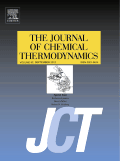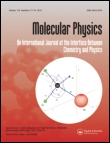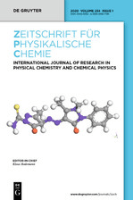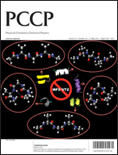
JOURNAL OF CHEMICAL THERMODYNAMICS
Scope & Guideline
Exploring the Depths of Molecular Interactions
Introduction
Aims and Scopes
- Thermodynamic Properties Measurement:
The journal emphasizes the accurate measurement of thermodynamic properties such as solubility, heat capacity, and phase equilibria, which are critical for understanding chemical systems. - Molecular Interaction Studies:
Research published in the journal often investigates intermolecular interactions through various methods, including calorimetry, spectroscopy, and molecular dynamics simulations, contributing to a deeper understanding of chemical behavior. - Modeling and Simulation:
The journal encourages the use of theoretical models and computational simulations to predict thermodynamic properties and behaviors, enabling researchers to validate experimental results and explore new systems. - Focus on Industrial and Pharmaceutical Applications:
Many studies address practical applications of thermodynamics in fields such as pharmaceuticals, materials science, and environmental chemistry, highlighting the journal's relevance to real-world challenges. - Diverse Chemical Systems:
The journal covers a wide variety of chemical systems, including ionic liquids, deep eutectic solvents, organic compounds, and gas mixtures, reflecting the interdisciplinary nature of thermodynamics.
Trending and Emerging
- Deep Eutectic Solvents:
Research on deep eutectic solvents has surged, driven by their potential for green chemistry applications and their unique thermodynamic properties, indicating a shift towards sustainable solvent systems. - Ionic Liquids:
The study of ionic liquids continues to expand, focusing on their thermodynamic properties, solubility behaviors, and applications in separation processes and catalysis. - Thermodynamics of Drug Solubility:
There is an increasing emphasis on the thermodynamics of drug solubility and interactions within pharmaceutical contexts, reflecting the importance of solubility in drug formulation and delivery. - High-pressure and High-temperature Studies:
Research exploring thermodynamic properties under extreme conditions is trending, particularly in the context of energy applications and materials science, highlighting the relevance of these studies to modern technology. - Molecular Dynamics and Computational Chemistry:
The integration of molecular dynamics simulations and computational chemistry techniques is gaining popularity, allowing for detailed insights into molecular interactions and the prediction of thermodynamic properties.
Declining or Waning
- Traditional Solvent Systems:
There has been a noticeable decrease in studies focusing solely on traditional solvent systems, as researchers increasingly explore more complex or novel solvent mixtures, such as deep eutectic solvents. - Basic Thermodynamic Principles:
Papers that solely reiterate fundamental thermodynamic principles without novel applications or insights have become less frequent, indicating a shift towards more applied and innovative research. - Single-component Systems:
Research on single-component thermodynamic systems is less prominent, as the focus has shifted towards multi-component systems and their interactions, reflecting a growing interest in complexity. - Static Measurement Techniques:
The prevalence of static measurement techniques has declined in favor of dynamic and real-time measurements, which better capture the complexities of chemical behaviors under varied conditions. - Low-temperature Studies:
There is a waning interest in low-temperature thermodynamic studies, as current research trends prioritize high-temperature and high-pressure conditions relevant to industrial applications.
Similar Journals

MOLECULAR PHYSICS
Pioneering research in biophysics and beyond.MOLECULAR PHYSICS, published by Taylor & Francis Ltd, is a distinguished international journal that has been advancing the fields of biophysics, condensed matter physics, molecular biology, and physical and theoretical chemistry since its inception in 1958. With an ISSN of 0026-8976 and an E-ISSN of 1362-3028, the journal provides a rich platform for the dissemination of high-quality research, evidenced by its Q3 ranking in several domains including both biophysics and condensed matter physics as of 2023. Although the journal operates on a traditional subscription model rather than an Open Access basis, its rigorous selection process ensures the publication of relevant and impactful articles. The journal's continued convergence of research until 2024 underlines its ongoing significance and adaptability in an ever-evolving scientific landscape. For researchers, professionals, and students alike, MOLECULAR PHYSICS serves as an essential resource for keeping abreast of the latest developments, fostering collaboration, and inspiring future advancements in molecular theory and applications.

Liquid Crystals Reviews
Advancing Knowledge in Liquid Crystal TechnologyLiquid Crystals Reviews, published by Taylor & Francis Ltd, is an esteemed journal dedicated to the nuanced field of liquid crystal technology and its applications. With an ISSN of 2168-0396 and an E-ISSN of 2168-0418, this journal has established itself as a vital resource for researchers, professionals, and students alike, providing a platform for rigorous peer-reviewed articles and innovative research findings. Impressively, it holds a Q1 ranking in Chemistry, Condensed Matter Physics, and Materials Science as of 2023, underscoring its significance in these disciplines. The journal spans a convergence period from 2013 to 2024, inviting high-quality contributions that lead to foundational advancements in understanding the properties and uses of liquid crystals. While the journal is not open access, its impact on the scientific community is profound, serving as a cornerstone for knowledge dissemination and advancement in liquid crystal research. Located in the United States with its publishing office in England, Liquid Crystals Reviews operates at the crossroads of innovation and academic excellence.

Journal of Applied Mechanics and Technical Physics
Connecting Scholars to the Future of Applied PhysicsJournal of Applied Mechanics and Technical Physics is a distinguished publication that serves as a vital resource for researchers and professionals in the realms of mechanical engineering, mechanics of materials, and condensed matter physics. Published by MAIK NAUKA/INTERPERIODICA/SPRINGER, this journal has been committed to disseminating high-quality research since its inception in 1965. With a noted presence in the academic community, it holds a respectable Q3 ranking in multiple categories as of 2023, indicating its relevance and contribution to the field. Although it does not currently offer open access, the journal provides valuable insights and advancements through its rigorous peer-review process. Covering a broad spectrum of topics in applied mechanics and technical physics, it aims to foster innovation and dialogue among scientists, engineers, and scholars alike. Located in the United States, the journal continues to make significant strides in bridging the gap between theoretical research and practical applications, making it an essential read for anyone engaged in these dynamic fields.

ZEITSCHRIFT FUR PHYSIKALISCHE CHEMIE-INTERNATIONAL JOURNAL OF RESEARCH IN PHYSICAL CHEMISTRY & CHEMICAL PHYSICS
Pioneering Insights in Physical ChemistryZEITSCHRIFT FUR PHYSIKALISCHE CHEMIE-INTERNATIONAL JOURNAL OF RESEARCH IN PHYSICAL CHEMISTRY & CHEMICAL PHYSICS, published by WALTER DE GRUYTER GMBH, is a highly regarded platform for researchers in the field of physical chemistry and chemical physics. With an ISSN of 0942-9352 and an E-ISSN of 2196-7156, this journal serves as a vital resource for the dissemination of original research, critical reviews, and insightful discussions that span theoretical and experimental investigations. Recognized for its quality, it holds a Q2 classification within the 2023 quartiles of Physical and Theoretical Chemistry and ranks 72nd out of 189 in the Scopus database, placing it in the 62nd percentile. The journal’s extensive publication history, originating from 1943, showcases its long-standing commitment to advancing the understanding of complex chemical phenomena. Although it currently does not offer open-access options, it continues to attract contributions from leading experts worldwide, making it essential reading for professionals, researchers, and students dedicated to pushing the frontiers of chemical science. The journal is located in Berlin, Germany, at Genthiner Strasse 13, D-10785 Berlin, Germany.

INTERNATIONAL JOURNAL OF REFRIGERATION
Fostering interdisciplinary dialogue in cooling technologies.International Journal of Refrigeration, published by Elsevier Science Ltd, is a leading periodical dedicated to advancing the field of refrigeration and its applications. With an impressive impact factor and ranking in the top quartile (Q1) of both Building and Construction and Mechanical Engineering categories, this journal has been instrumental in disseminating innovative research and breakthroughs since its inception in 1978. Covering a vast array of topics related to refrigeration technology, thermodynamics, and energy efficiency, it serves as an essential resource for researchers, engineers, and students alike. By providing high-quality, peer-reviewed articles, it aims to foster interdisciplinary dialogue and contribute significantly to the development of sustainable practices in the refrigeration sector. Although the journal does not offer open access options at present, its rigorous publication standards ensure that the latest advancements reach a broad audience in the academic and professional communities.

Central European Journal of Energetic Materials
Exploring Innovations in Materials ChemistryWelcome to the Central European Journal of Energetic Materials, a distinguished publication in the field of energetic materials, published by the INST INDUSTRIAL ORGANIC CHEMISTRY in Poland. This journal, with ISSN 1733-7178, has been a vital platform for researchers since its inception in 2009, promoting the latest advancements and discoveries in the dynamic fields of Materials Chemistry and Organic Chemistry. With an admirable presence in the academic community, it boasts a Q3 ranking in Materials Chemistry and a Q4 ranking in Organic Chemistry for 2023, showcasing its contribution to foundational research despite competitive challenges. Researchers looking to disseminate their findings will find this journal a reputable venue, supported by rigorous peer-review processes and a commitment to open dialogue within the scientific community. The journal is pivotal for academics, professionals, and students interested in the synthesis, characterization, and application of energetic materials, making it a notable resource for understanding the complexities and innovations within this specialized domain.

PHYSICAL CHEMISTRY CHEMICAL PHYSICS
Bridging Disciplines for a Deeper Understanding of Chemical PhenomenaPhysical Chemistry Chemical Physics is a premier interdisciplinary journal published by the Royal Society of Chemistry, dedicated to advancing the fields of physical chemistry and chemical physics. With an impressive impact factor and categorized in the Q2 quartiles for both Physical and Theoretical Chemistry and Physics and Astronomy, this journal serves as a vital platform for the dissemination of high-quality research findings from 1999 through 2024. Based in the United Kingdom, the journal is committed to providing open access to its articles, enhancing the visibility and accessibility of research to a global audience. Researchers, professionals, and students alike are encouraged to contribute to this esteemed journal, ensuring impactful discussions and significant advancements in the understanding of chemical and physical phenomena. With strong Scopus rankings underscoring its relevance, Physical Chemistry Chemical Physics stands out as an essential resource for specialists striving to innovate and excel within these dynamic fields.

RUSSIAN JOURNAL OF INORGANIC CHEMISTRY
Championing Excellence in Chemical ResearchThe Russian Journal of Inorganic Chemistry is a distinguished publication that delves into the fundamental and applied aspects of inorganic chemistry. Published by MAIK Nauka/Interperiodica/Springer, this journal has established itself as a vital resource for researchers, professionals, and students alike, contributing significantly to the fields of Inorganic Chemistry, Materials Science, and Physical and Theoretical Chemistry. With an ISSN of 0036-0236 and an E-ISSN of 1531-8613, the journal is indexed for easy access and citation. Though the journal currently operates under a subscription model, its commitment to disseminating high-quality research and fostering scientific discourse remains steadfast. The journal has been maintaining a consistent record since its inception, and its positioning in the Q3 quartile across various chemistry categories in 2023 underscores its relevance in the academic community. As it continues through its converged years from 1996 to 2024, the Russian Journal of Inorganic Chemistry plays a pivotal role in enhancing the understanding and advancement of inorganic chemistry, making it an indispensable tool for anyone engaged in this dynamic field.

Annual Review of Physical Chemistry
A Scholarly Nexus for Physical Chemistry ExcellenceAnnual Review of Physical Chemistry, published by Annual Reviews, stands as a premier source of comprehensive review articles in the field of physical chemistry. With a prestigious impact factor and a strong reputation reflected in its Q1 rankings in both Physical and Theoretical Chemistry and Medicine (Miscellaneous), this journal is essential for researchers seeking to stay at the forefront of advancements in the discipline. Covering a wide array of topics, the Annual Review of Physical Chemistry synthesizes the latest findings, trends, and methodologies, providing a vital resource for professionals and students alike. Although it does not offer open access, its scholarly rigor and in-depth analyses ensure it occupies a critical space in academia. Its consistent publication since 1975 guarantees that it has historical significance and relevance, making it a cornerstone for those engaged in cutting-edge research within the realm of physical chemistry.

Russian Journal of Physical Chemistry A
Connecting Researchers Through Groundbreaking FindingsWelcome to the Russian Journal of Physical Chemistry A, a prominent publication in the field of Physical and Theoretical Chemistry, published by MAIK NAUKA/INTERPERIODICA/SPRINGER. This journal, with ISSN 0036-0244 and E-ISSN 1531-863X, has been a vital platform for disseminating significant research findings since its inception in 1996. As a key contributor to academic discourse, it aims to provide high-quality articles that explore fundamental and applied aspects of physical chemistry, thereby enhancing understanding and innovation in the discipline. Although currently categorized as Q4 by Scopus (2023), the journal is positioned to evolve with the scholarly landscape, continually striving to improve its impact and relevance. With no open access options available, subscription to this journal is essential for those keen on enriching their knowledge and staying current with advancements in physical chemistry. Researchers, professionals, and students alike will find invaluable insights and robust discussions that can inspire their work and studies.